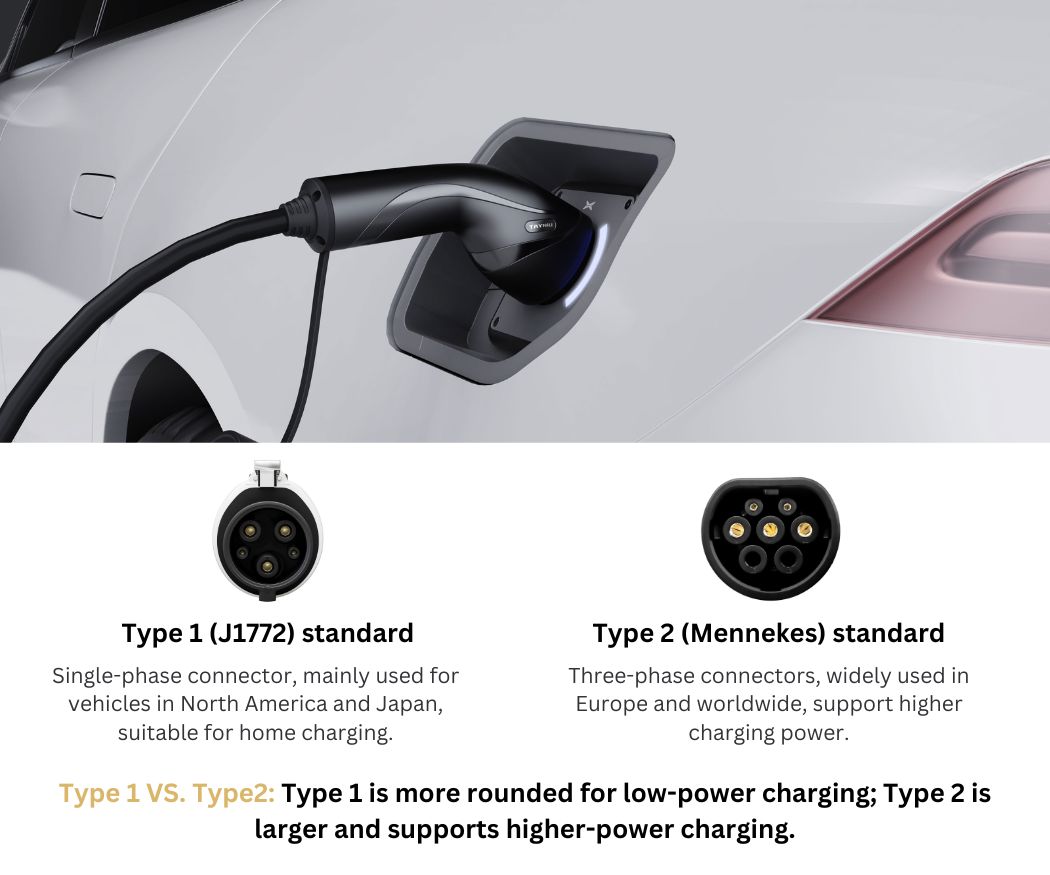Type 1 vs. Type 2: Which Charging Connector Fits Your EV?
Introduction
Choosing the right EV charger starts with knowing your EV’s charging port. With Type 1 and Type 2 connectors being the most common standards, understanding which one your car supports can make a big difference in your charging experience. This guide will help you identify whether your EV uses a Type 1 or Type 2 charging connector and explain what this means for your charging needs.

What Is a Type 1 EV Charging Port?
The Type 1 charging port, also known as the J1772 connector, is commonly used in North America and Japan. Here are its key features:
- Design: Single-phase connector with 5 pins.
- Maximum Power: Up to 7.4 kW.
- Compatibility: Ideal for home charging setups.
- Appearance: Smaller and rounded compared to Type 2 connectors.
Type 1 connectors are primarily used in vehicles manufactured for the North American market.
What Is a Type 2 EV Charging Port?
The Type 2 charging port, or Mennekes connector, is the standard across Europe and is gaining popularity worldwide. Key features include:
- Design: Three-phase connector with 7 pins.
- Maximum Power: Up to 22 kW (AC) or higher for DC charging.
- Compatibility: Supports both home and public charging.
- Appearance: Larger, with a flattened top edge.
Many newer EV models are equipped with Type 2 ports due to their versatility and higher power capabilities.
How to Check Your EV’s Charging Compatibility
Not sure which type your EV uses? Follow these steps:
1. Check Your EV Manual
Most EV manuals specify the type of charging port your vehicle supports. Look for the “Charging Specifications” section.
2. Look at Your Existing Charger
If you already have a portable or home charger, check its connector type. The design and number of pins will indicate whether it’s Type 1 or Type 2.
3. Consult a Charging Station Provider
Contact your EV dealer or a trusted charging station provider if you’re still unsure. They can confirm compatibility based on your EV model.
Why Knowing Your Charging Port Matters
Understanding your EV’s charging port is essential for:
- Choosing the Right Charger: Ensures compatibility with home and public charging stations.
- Maximizing Charging Efficiency: Helps you leverage faster charging speeds where available.
- Avoiding Compatibility Issues: Prevents potential damage to your vehicle or charger.
Comparison Table: Type 1 vs. Type 2
| Feature | Type 1 (J1772) | Type 2 (Mennekes) |
|---|---|---|
| Regions | North America, Japan | Europe, Worldwide |
| Power (AC) | Up to 7.4 kW | Up to 22 kW |
| Design | 5 pins, rounded | 7 pins, flattened top |
| Best Use | Home charging | Home and public charging |
Frequently Asked Questions (FAQ)
Q: Can I use a Type 2 charger with a Type 1 car?
A: No, the two connectors are not physically compatible. However, adapters are available for certain scenarios.
Q: What’s the difference between Type 1 and Type 2 charging?
A: The main differences are in design, power capacity, and regional usage. Type 2 supports higher power levels and is more common globally.
Q: Are Type 2 chargers faster than Type 1?
A: Yes, Type 2 chargers typically offer higher power levels, resulting in faster charging times.
Looking for a portable EV charger? Check out our Tayniu portable EV chargers.
Want to install a home charger? Visit our home EV charging guide.
Not sure which charger fits your needs? Contact us at Tayniu for expert guidance and explore our range of EV charging solutions designed to fit your lifestyle. Learn more.
Last Updated on January 6, 2025 by tayniu
